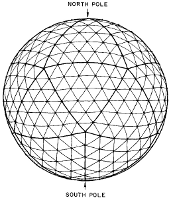
DYNAMICO
DYNAMICO project develops a new dynamical core for LMDZ, the atmospheric general circulation model (GCM) part of IPSL-CM Earth System Model.
The DYNAMICO project develops a new dynamical core for LMDZ, the atmospheric general circulation model (GCM) part of IPSL-CM Earth System Model.
LMDZ6, the current version of LMDZ, has a shallow-atmosphere, hydrostatic dynamical core. It is based on a latitude-longitude C-grid, a hybrid pressure-based terrain-following vertical coordinate, second-order enstrophy-conserving finite-difference discretization and positive-definite advection. Grid refinement is implemented as a continuous zoom via smooth grid stretching. An extensive package of physical paramererizations is coupled to the dynamical core. IPSL-CM is currently used to produce AR5 simulations. LMDZ is also at the heart of GCMs of planetary atmospheres (Mars, Venus and Titan).
It is well-known that the latitude-longitude coordinates have a strong singularity at the poles which is undesirable in terms of both numerical stability and computational efficiency. Regular tesselations of the sphere such as a recursively subdivided icosahedron provide an almost-uniform grid and a path to highly parallel computations based on domain decomposition. LMD’s logo is itself an icosahedron, evoking the pioneering work of Robert Sadourny on the use of icosahedral grids for solving the equations of atmospheric motion.
The primary goal of DYNAMICO is to re-formulate in LMDZ the horizontal advection and dynamics on a icosahedral grid, while preserving or improving their qualities with respect to accuracy, conservation laws and wave dispersion. In turn, a new grid refinement strategy is required. A broader goal is to revisit all fundamental features of the dynamical core, especially the shallow-atmosphere approximation, the vertical coordinate and the coupling with physics. Efficient implementation on present and future supercomputing architectures is also a key issue addressed by DYNAMICO.
DYNAMICO is funded by the Indo-French Centre for the Promotion of Advanced Research. It is currently seeking funding from the IPSL and the G8 Research Councils Initiative on Multilateral Research Funding.


